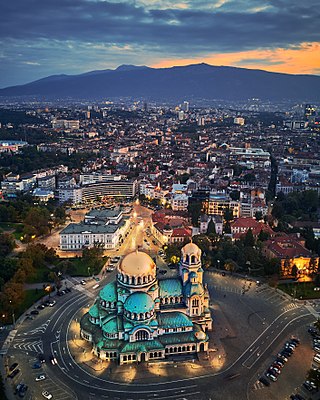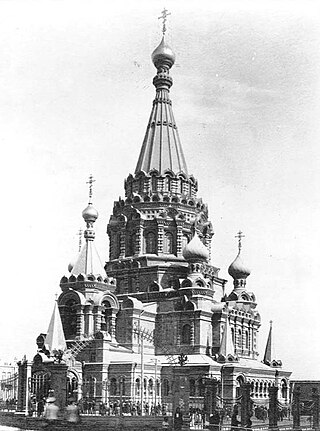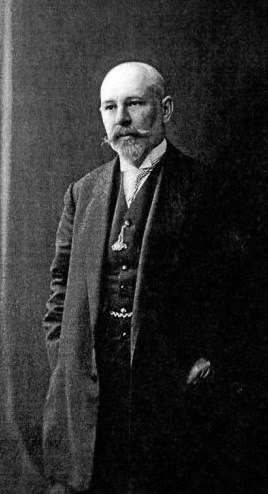
Yalta is a resort city on the south coast of the Crimean Peninsula surrounded by the Black Sea. It serves as the administrative center of Yalta Municipality, one of the regions within Crimea. Yalta, along with the rest of Crimea, is internationally recognised as part of Ukraine, and is considered part of the Autonomous Republic of Crimea. However, it is under the control of Russia, which annexed Crimea in 2014 and regards the town as part of the Republic of Crimea. According to the most recent census, its population was 76,746 .

Neo-Byzantine architecture was a revival movement, most frequently seen in religious, institutional and public buildings. It incorporates elements of the Byzantine style associated with Eastern and Orthodox Christian architecture dating from the 5th through 11th centuries, notably that of Constantinople and the Exarchate of Ravenna.

Kazan Cathedral or Kazanskiy Kafedralniy Sobor, also known as the Cathedral of Our Lady of Kazan, is a cathedral of the Russian Orthodox Church on the Nevsky Prospekt in Saint Petersburg. It is dedicated to Our Lady of Kazan, one of the most venerated icons in Russia.

Livadia Palace is a former summer retreat of the last Russian tsar, Nicholas II, and his family in Livadiya, Crimea. The Yalta Conference was held there in 1945, when the palace housed the apartments of Franklin Delano Roosevelt and other members of the American delegation – the Soviet delegation was housed in the Yusupov Palace, and the British in the Vorontsov Palace some eight kilometers distant. The palace houses a museum, and is sometimes used for international summits.

St. Alexander Nevsky Cathedral is a Bulgarian Orthodox cathedral in Sofia, the capital of Bulgaria. Built in Neo-Byzantine style, it serves as the cathedral church of the Patriarch of Bulgaria and it is one of the 50 largest Christian church buildings by volume in the world. It is one of Sofia's symbols and primary tourist attractions. St. Alexander Nevsky Cathedral in Sofia occupies an area of 3,170 square metres (34,100 sq ft) and can hold 5,000 people inside. It is among the 10 largest Eastern Orthodox church buildings. It is the largest cathedral in the Balkans. It is believed that up until the year 2000 it was the largest finished Orthodox cathedral.

The Alexander Nevsky Cathedral of Tallinn is an Eastern Orthodox cathedral in central Tallinn, Estonia. It was built in 1894–1900, when the country was part of the former Russian Empire. The cathedral is the city's largest cupola church. The late Patriarch Alexy II of Moscow (1929–2008) started his priestly ministry in the cathedral.

The Russian Church, officially known as the Church of St Nicholas the Miracle-Maker, is a Russian Orthodox church in central Sofia, Bulgaria situated on Tsar Osvoboditel Boulevard.

The Alexander Nevsky Cathedral was the main Russian Orthodox cathedral in Baku, Azerbaijan from when it was completed in 1898 until its destruction in 1937 during the Soviet era under Joseph Stalin. The cathedral was the biggest Russian Orthodox structure ever built in the South Caucasus.
The appearance of Saint Petersburg includes long, straight boulevards, vast spaces, gardens and parks, decorative wrought-iron fences, monuments and decorative sculptures. The Neva River itself, together with its many canals and their granite embankments and bridges help to give the city its particular ambience.

Transfiguration Cathedral is an Eastern Orthodox cathedral. It is located on Transfiguration Square, just off Liteyny Prospekt near the Chernyshevskaya metro station. Unlike most Russian churches, it has never ceased operating as a place of worship.

Russian-Byzantine architecture is a revivalist direction in Russian architecture and decorative and applied arts, based on the interpretation of the forms of Byzantine and Ancient Russian architecture. As part of eclecticism could be combined with other styles.

The Alexander Nevsky Church is the only Russian Orthodox church in Copenhagen. It was built by the Russian Government between 1881 and 1883, prompted by Princess Dagmar of Denmark's marriage to Alexander Alexandrovich on 9 November 1866 and their later ascent to the Russian throne as Tsar Alexander III of Russia and Tsaritsa Maria Feodorovna. The church is dedicated to the Russian patron saint Alexander Nevsky.

The Metropolitan Cathedral of the Holy and Equal-to-the-Apostles Mary Magdalene is a Polish Orthodox cathedral, located at al. Solidarności 52 in Warsaw.

Nikolay Petrovich Krasnov was a Russian Serbian architect and painter, who served as Chief Architect of Yalta, Crimea, between 1887 and 1899. From 1922 he lived and worked in the Kingdom of Yugoslavia, and was a key figure in the architectural development of Belgrade.

Church of St. Alexander Nevsky ― an Orthodox church of Rostov and Novocherkassk Diocese. It is situated in the city of Novocherkassk, Rostov Oblast, Russia.

The Holy Trinity Cathedral of the Alexander Nevsky Lavra is a Russian Orthodox cathedral in Saint Petersburg. It is in the Diocese of Saint Petersburg and part of the Alexander Nevsky Lavra, where it is the cathedral church of the monastery complex.

The Gate Church, or formally the Church of the Icon of the Mother of God Joy of All Who Sorrow is a Russian Orthodox church in Saint Petersburg. It is in the Diocese of Saint Petersburg and is part of the Alexander Nevsky Lavra.

The Orthodox Cathedral of St. Nicholas in Białystok is an historic Orthodox cathedral in Bialystok, Poland

St. Nicholas Cathedral is the main church of the Kuopio Orthodox Parish in Väinölänniemi, Kuopio, Finland, and also the seat of the Orthodox Diocese of Karelia. The church was completed in 1903 and is dedicated to the memory of Saint Nicholas. The church, built between 1902 and 1903, was designed by the master builder Aleksander Isakson from Vyborg. The facade is plastered and painted to look like red brick, but there is also genuine brick under the plaster. In appearance, it resembles red-brick simultaneous garrison churches. The iconostasis was made at the Alexander Nevsky Lavra in Saint Petersburg and was donated by Nikolay Bobrikov, the Governor-General of Finland. There are eight bells in the cathedral.

Feodorovskaya Icon Cathedral — an Orthodox church in Saint Petersburg, Russia. It belongs to the Central Deanery of the St. Petersburg Diocese of the Russian Orthodox Church. The cathedral was built in Commemoration of the Romanov Tercentenary.





















